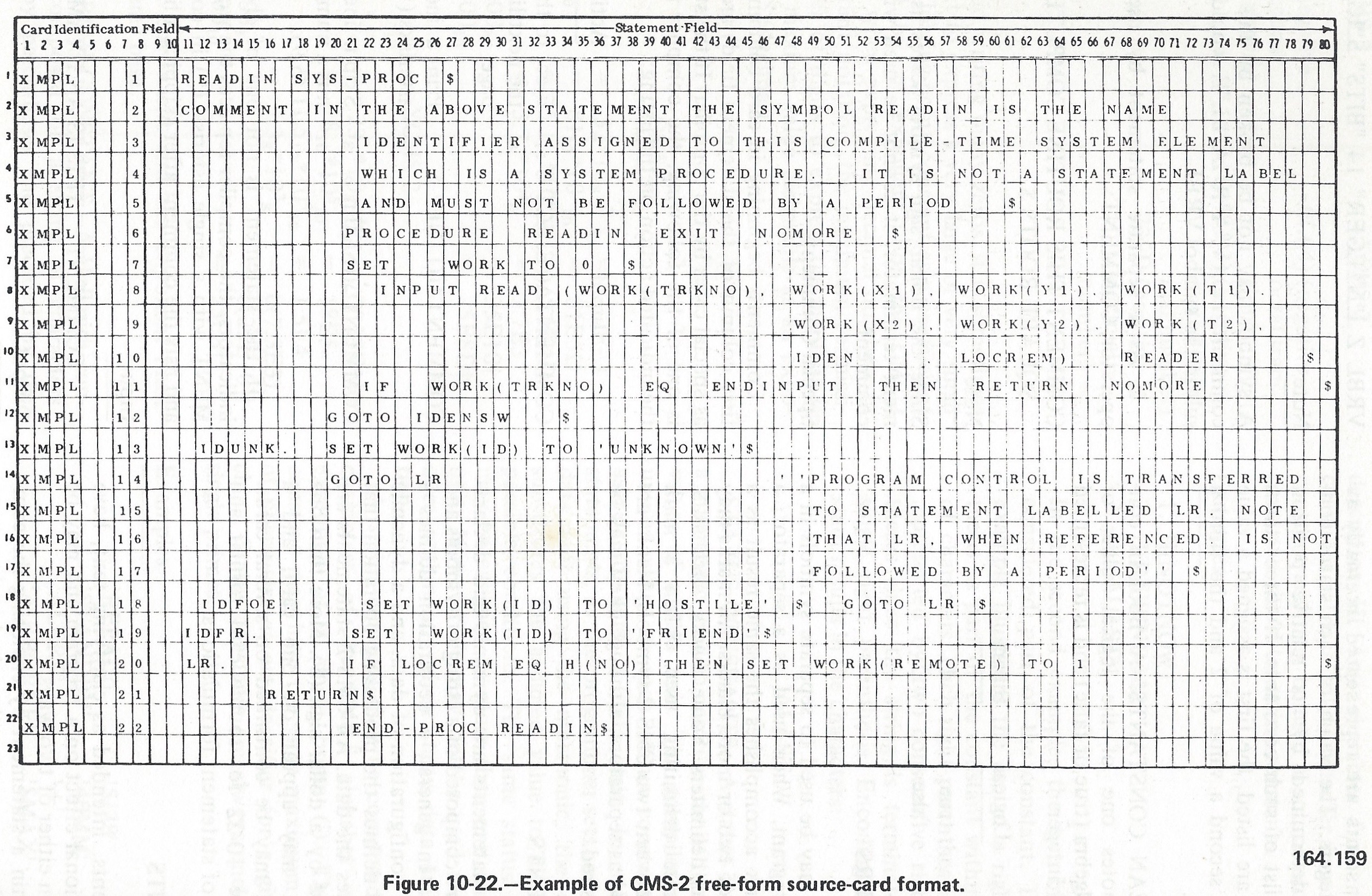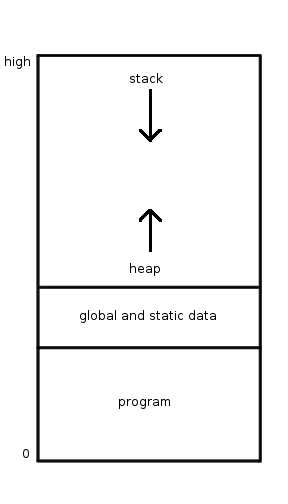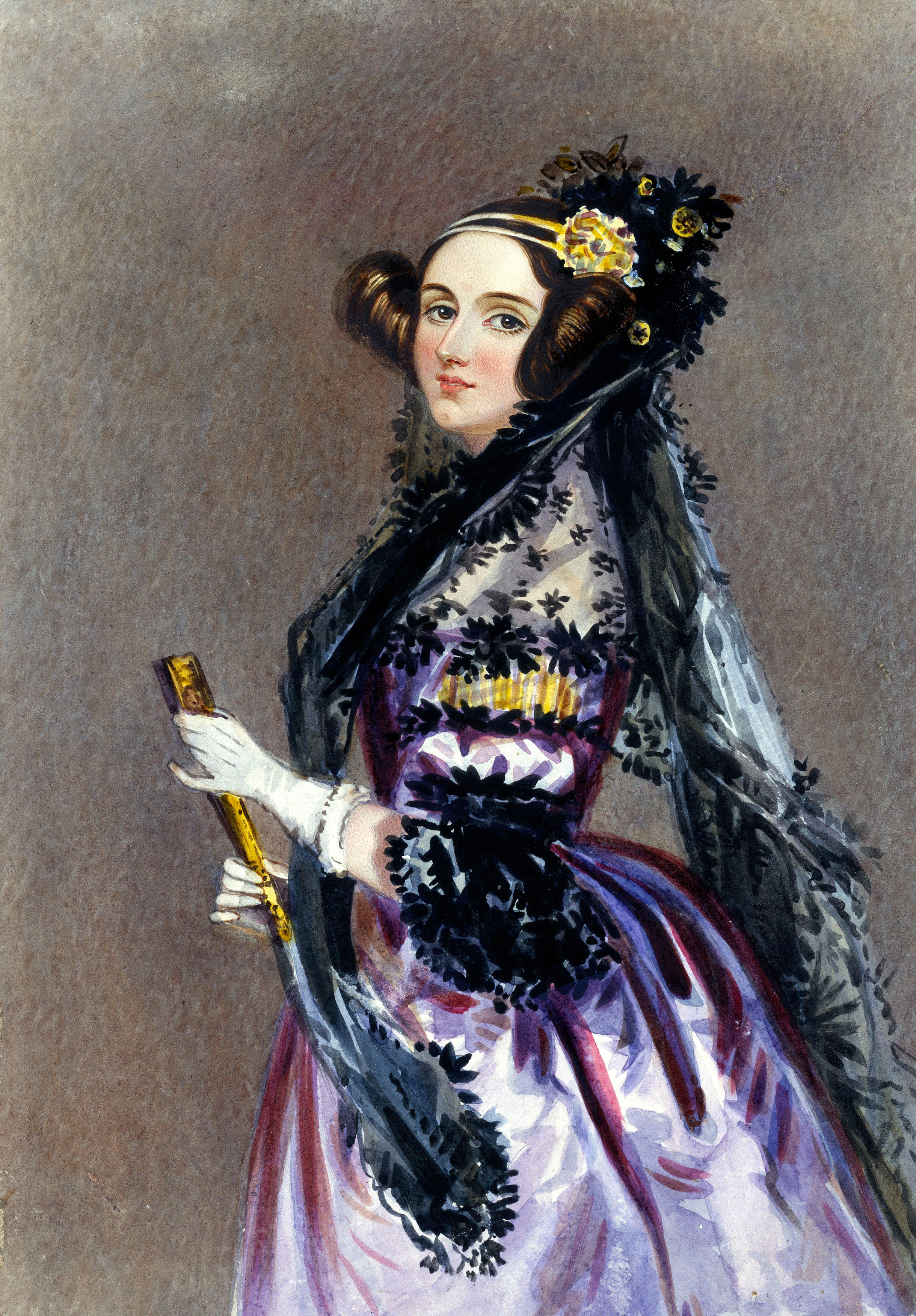|
CMS-2 (programming Language)
CMS-2 is an embedded systems programming language used by the United States Navy. It was an early attempt to develop a standardized high-level computer programming language intended to improve code portability and reusability. CMS-2 was developed primarily for the US Navy’s tactical data systems ( NTDS). CMS-2 was developed by RAND Corporation in the early 1970s and stands for "Compiler Monitor System". The name "CMS-2" is followed in literature by a letter designating the type of target system. For example, CMS-2M targets Navy 16-bit processors, such as the AN/AYK-14. History CMS-2 was developed for FCPCPAC (Fleet Computer Programming Center - Pacific) in San Diego, CA. It was implemented by Computer Sciences Corporation in 1968 with design assistance from Intermetrics. The language continued to be developed, eventually supporting a number of computers including the AN/UYK-7 and AN/UYK-43 and UYK-20 and UYK-44 Mark Wilson - personal experience working with UYK-20 and UYK-4 ... [...More Info...] [...Related Items...] OR: [Wikipedia] [Google] [Baidu] |
Imperative Programming
In computer science, imperative programming is a programming paradigm of software that uses Statement (computer science), statements that change a program's state (computer science), state. In much the same way that the imperative mood in natural languages expresses commands, an imperative program consists of command (computing), commands for the computer to perform. Imperative programming focuses on describing ''how'' a program operates step by step (with general order of the steps being determined in source code by the placement of statements one below the other), rather than on high-level descriptions of its expected results. The term is often used in contrast to declarative programming, which focuses on ''what'' the program should accomplish without specifying all the details of ''how'' the program should achieve the result. Procedural programming Procedural programming is a type of imperative programming in which the program is built from one or more procedures (also termed s ... [...More Info...] [...Related Items...] OR: [Wikipedia] [Google] [Baidu] |
AN/UYK-7
The AN/UYK-7 was the standard 32-bit computer of the United States Navy for surface ship and submarine platforms, starting in 1970. It was used in the Navy's NTDS & Aegis combat systems and U.S. Coast Guard, and the navies of U.S. allies. It was also used by the U.S. Army. In accordance with the Joint Electronics Type Designation System (JETDS), the "''AN/UYK-7''" designation represents the 7th design of an Army-Navy electronic device for general utility data processing computing equipment. The JETDS system also now is used to name all Department of Defense electronic systems. Technical Built by UNIVAC, it used integrated circuits, had 18-bit addressing and could support multiple CPUs and I/O controllers. Three CPUs and two I/O controllers were a common configuration. Its multiprocessor architecture was based upon the UNIVAC 1108. An airborne version, the UNIVAC 1832, was also produced. Replacement In the mid-1980s, the UYK-7 was replaced by the AN/UYK-43 which shared th ... [...More Info...] [...Related Items...] OR: [Wikipedia] [Google] [Baidu] |
AN/USQ-17
The AN/USQ-17 or Naval Tactical Data System (NTDS) computer referred to in Sperry Rand documents as the Univac M-460, was Seymour Cray's last design for UNIVAC. UNIVAC later released a commercial version, the UNIVAC 490. That system was later upgraded to a multiprocessor configuration as the 494. In accordance with the Joint Electronics Type Designation System (JETDS), the "''AN/USQ-17''" designation represents the 17th design of an Army-Navy Electronics, electronic device for general utility special combination equipment. The JETDS system also now is used to name all Department of Defense electronic systems. Overview The machine was the size and shape of a refrigerator, about four feet high (roughly 1.20 meters), with a hinged lid for access. Shortly after completing the prototype design, Cray left to join Control Data Corporation. When the Navy awarded Sperry Rand a US$50 million contract to build the AN/USQ-17, Univac engineers redesigned the entire machine from scratch using s ... [...More Info...] [...Related Items...] OR: [Wikipedia] [Google] [Baidu] |
AN/UYK-44
The AN/UYK-44 was the standard 16-bit minicomputer of the United States Navy developed in the early 1980s by Sperry Corporation and was completed in early 1984. The AN/UYK-44 was used in surface ships, submarines, ground C4I platforms, radar and missile control systems. The system was designed to replace the older AN/UYK-20 model. In accordance with the Joint Electronics Type Designation System (JETDS), the "''AN/UYK-44''" designation represents the 44th design of an Army-Navy electronic device for general utility data processing computing equipment. The JETDS system also now is used to name all Department of Defense electronic systems. Technical specifications The AN/UYK-44 had 2 million words of memory, approximately 4 MB in modern terms, and operated at 0.9 MIPS. The system has relatively large I/O capability and has a MIL-STD-1397 point-to-point I/O bus running at 250K words/s. The system was built around the use of "Standard Electronic Modules" (SEM) for logic implemen ... [...More Info...] [...Related Items...] OR: [Wikipedia] [Google] [Baidu] |
AN/UYK-20
The AN/UYK-20 Data Processing Set was a Ruggedized PC, ruggedized small computer manufactured by Univac and used by the United States Navy for small and medium-sized shipboard and shore systems built in the 1970s. It featured non-volatile magnetic core memory and was housed in a heavy-duty metal cube-shaped box which was designed to fit through a 25-inch circular hatch. In 1972, in response to the proliferation of small computer types in the Navy's inventory, the Chief of Naval Material mandated the use of the AN/UYK-20(V) in systems requiring a small digital processor. In March 1974 the AN/UYK-20 received service approval and by late 1974 they were in use in the development of tactical systems. Programmers and operators colloquially referred to this computer as the "Yuck Twenty." In accordance with the Joint Electronics Type Designation System (JETDS), the "''AN/UYK-20''" designation represents the 20th design of an Army-Navy Electronics, electronic device for general utility ... [...More Info...] [...Related Items...] OR: [Wikipedia] [Google] [Baidu] |
Ada (programming Language)
Ada is a structured, statically typed, imperative, and object-oriented high-level programming language, inspired by Pascal and other languages. It has built-in language support for '' design by contract'' (DbC), extremely strong typing, explicit concurrency, tasks, synchronous message passing, protected objects, and non-determinism. Ada improves code safety and maintainability by using the compiler to find errors in favor of runtime errors. Ada is an international technical standard, jointly defined by the International Organization for Standardization (ISO), and the International Electrotechnical Commission (IEC). , the standard, ISO/IEC 8652:2023, is called Ada 2022 informally. Ada was originally designed by a team led by French computer scientist Jean Ichbiah of Honeywell under contract to the United States Department of Defense (DoD) from 1977 to 1983 to supersede over 450 programming languages then used by the DoD. Ada was named after Ada Lovelace (1815–185 ... [...More Info...] [...Related Items...] OR: [Wikipedia] [Google] [Baidu] |
UNIVAC 418
The UNIVAC 418 was a transistorized computer made by Sperry Univac. It had 18-bit words and used magnetic-core memory. The name came from its 4-microsecond memory cycle time and 18-bit word. The assembly language for this class of computers was TRIM III and ART418. Over the three different models, more than 392 systems were manufactured. It evolved from the Control Unit Tester (CUT), a device used in the factory to test peripherals for larger systems. Architecture The instruction word had three formats: :''Format I'' - common Load, Store, and Arithmetic operations *f - Function code (6 bits) *u - Operand address (12 bits) :''Format II'' - Constant arithmetic and Boolean functions *f - Function code (6 bits) *z - Operand address or value (12 bits) :''Format III'' - Input/Output *f - Function code (6 bits) *m - Minor function code (6 bits) *k - Designator (6 bits) used for channel number, shift count, etc. Numbers were represented in ones' complement, single and double precis ... [...More Info...] [...Related Items...] OR: [Wikipedia] [Google] [Baidu] |
Resident Monitor
In computing, a resident monitor is a type of system software program that was used in many early computers from the 1950s to 1970s. It can be considered a precursor to the operating system. The name is derived from a program which is always present in the computer's memory, thus being ''resident''. Because memory was very limited on those systems, the resident monitor was often little more than a stub that would gain control at the end of a job and load a non-resident portion to perform required job cleanup and setup tasks. On a general-use computer using punched card input, the resident monitor governed the machine before and after each job control card was executed, loaded and interpreted each control card, and acted as a job sequencer for batch processing operations. The resident monitor could clear memory from the last used program (with the exception of itself), load programs, search for program data and maintain standard input-output routines in memory. Similar system ... [...More Info...] [...Related Items...] OR: [Wikipedia] [Google] [Baidu] |
AN/USQ-20
The AN/USQ-20, or CP-642 or Naval Tactical Data System (NTDS), was designed as a more reliable replacement for the Seymour Cray-designed AN/USQ-17 with the same instruction set. The first batch of 17 computers were delivered to the Navy starting in early 1961. A version of the AN/USQ-20 for use by the other military services and NASA was designated the UNIVAC 1206. Another version, designated the G-40, replaced the vacuum tube UNIVAC 1104 in the BOMARC Missile Program. In accordance with the Joint Electronics Type Designation System (JETDS), the "''AN/USQ-20''" designation represents the 20th design of an Army-Navy electronic device for general utility special combination equipment. The JETDS system also now is used to name all Department of Defense electronic systems. Technical The machine was the size and shape of an old-fashioned double-door refrigerator, about six feet tall (roughly 1.80 meters). Instructions were represented as 30-bit words in the following forma ... [...More Info...] [...Related Items...] OR: [Wikipedia] [Google] [Baidu] |
Blocks Of Statements
In computer programming, a block or code block or block of code is a lexical structure of source code which is grouped together. Blocks consist of one or more declarations and statements. A programming language that permits the creation of blocks, including blocks nested within other blocks, is called a block-structured programming language. Blocks are fundamental to structured programming, where control structures are formed from blocks. Blocks have two functions: to group statements so that they can be treated as one statement, and to define scopes for names to distinguish them from the same name used elsewhere. In a block-structured programming language, the objects named in outer blocks are visible inside inner blocks, unless they are masked by an object declared with the same name. History Ideas of block structure were developed in the 1950s during the development of the first autocodes, and were formalized in the Algol 58 and Algol 60 reports. Algol 58 introduced th ... [...More Info...] [...Related Items...] OR: [Wikipedia] [Google] [Baidu] |
AN/UYK-43
The AN/UYK-43 was the standard 32-bit computer of the United States Navy for surface ship and submarine platforms, with the first unit delivered in October, 1984. Some 1,250 units were delivered through to 2000. The size of a refrigerator, it replaced the older AN/UYK-7, both built by UNISYS and shared the same instruction set. An enhancement to the UYK-43, the Open Systems Module (OSM), allows up to six VMEbus Type 6U commercial off-the-shelf (COTS) cards to be installed in a UYK-43 enclosure. In accordance with the Joint Electronics Type Designation System (JETDS), the "''AN/UYK-43''" designation represents the 43rd design of an Army-Navy electronic device for general utility data processing computing equipment. The JETDS system also now is used to name all Department of Defense electronic systems. The UYK-43 is being replaced by commercial off-the-shelf systems. Retired systems are being cannibalized for repair parts to support systems still in use by U.S. and non-U.S. forces. ... [...More Info...] [...Related Items...] OR: [Wikipedia] [Google] [Baidu] |


